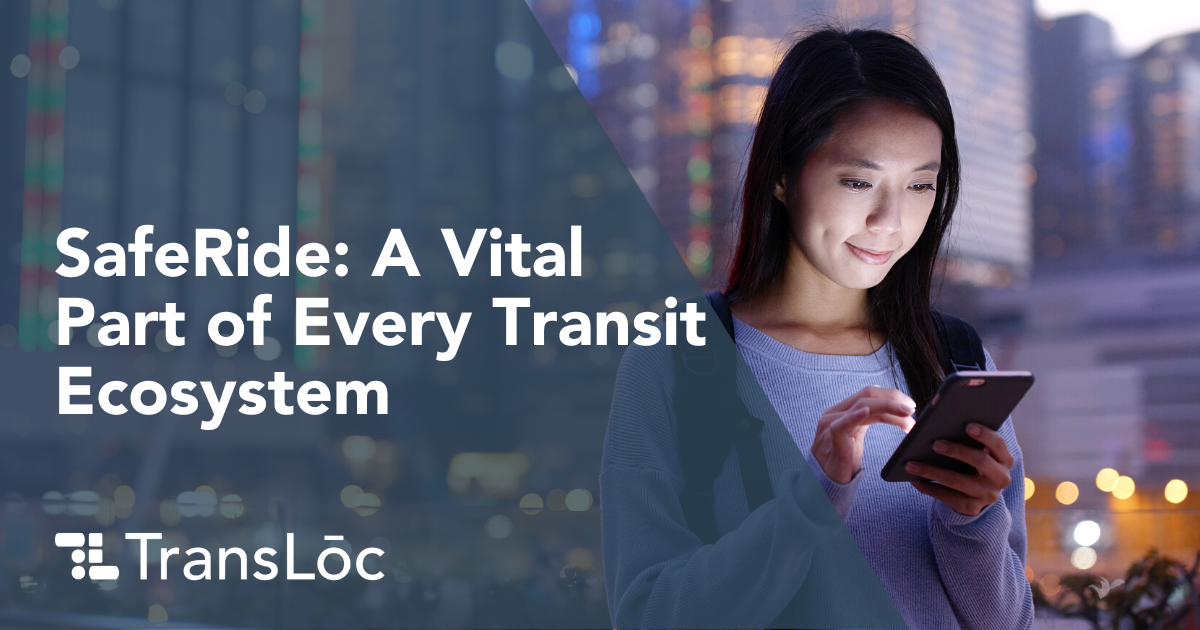
Post-pandemic ridership is rebounding rapidly. According to the American Public Transportation Association’s (APTA) Ridership Trends Dashboard, ridership has seen more than a 70% lift in the US transit industry, as fewer and fewer folks are content to be stuck at home, or have obligations to head back into the office or the classroom.
Among myriad factors to consider with this sharp uptick in ridership are flexibility, adaptation, and safety. Perhaps more now than ever, people are keenly aware of their surroundings and the importance of being able to access their schools and communities safely. For agencies or campuses that operate within a smaller ecosystem and have fewer resources than many larger, more established transit systems, this is an especially pertinent issue.
One solution organizations are increasingly adopting is the establishment of on-demand Safe Ride services. Such services are branded and managed with a focus on rider security and independence. Let’s talk a little more about why Safe Ride programs are becoming an increasingly prevalent component of a well-rounded transit ecosystem.
Why Safe Ride?
Many riders without access to personal transportation have obligations outside of regular bus systems’ service hours. However, there are often limits to operating hours for most fixed route operations due to reduced demand, limited ridership, finite budgets, or all the above. Late night travel becomes more of a safety issue as the protective guard of daylight disappears, public spaces become more desolate, and operations slow down or pause.
Security is particularly relevant on college and university campuses, where a reported 13% of students on average experience assault. Campuses such as Indiana University and University of Virginia (UVA) have recognized the need to provide safer options campus-wide. Each of these institutions sought to develop their own Safe Ride programs to provide transportation for students, faculty, and staff during evening and late-night hours. With the help of TransLoc’s OnDemand solution, the aforementioned institutions were able to carve out and define a Safe Ride program of their own to ensure their riders were able to study, work, and have fun past normal operating hours.
How Does TransLoc OnDemand Provide Safe Ride Services?
Similar to ride-hailing services such as Uber or Lyft, TransLoc’s OnDemand microtransit solution has taken a prominent role in the transit ecosystem. This adaptable solution fills service gaps to less-traveled locations and provides support during leaner hours when fixed route options are slim or not available, at a lower overhead cost.
The flexibility of an OnDemand service supports any campus or agency seeking to create a safe system. Many campuses and municipalities have adopted TransLoc OnDemand to adjust for nuances in their daily operations and streamline their rider services. OnDemand services have a broader scope of control and customization and provide data which helps drive meaningful decisions and changes; all of which build a strong foundation for a Safe Ride program.
With TransLoc’s user-friendly OnDemand solution, campuses and agencies can:
- Determine the hours of their Safe Ride operation and service areas, including key pick-up and drop-off locations
- Track vehicles on the backend
- Integrate with the OnDemand API to enable personalized service offerings and customization of the booking flow
- Provide riders with the ability to request rides, see vehicle availability, and get arrival notifications
OnDemand services also provide more control of external factors, including who is driving the vehicles, how long wait times should last before employing alternatives, and branding, using our White Label solution.
Best Practices for Safe Ride Programs
There are a few key factors to consider when establishing a Safe Ride program, regardless of the tools and resources an organization may use to build it.
- Start small, review the data, and alter as necessary. Determine where riders are going, particularly places where they may be more vulnerable, and ensure those areas are being serviced. Look at rider data, implement frequent rider surveys, and don’t be afraid to tweak services along the way. Our customer experience and operations teams are more than happy to provide guidance and assistance.
- Branding promotes confidence. Consistently use recognizable names, colors, and logos on mobile and web apps, landing pages, vehicles, etc. Focus marketing to key eligible populations so they’re aware of the Safe Ride program, how it works, and how to use it. This creates confidence which is especially important for a Safe Ride program.
- Provide broad late-night service hours, if possible.
- Vet and use student drivers on college campuses. This can create more of a sense of ease for the rider and provide opportunities to students looking to snag a few extra bucks.
- Consider free or reduced rates for students, faculty, staff (this could be baked into tuition), as well as disabled, elderly, veterans, and so on.
- Partner with Lyft or Uber to fill service gaps late at night so a rider doesn’t have to wait longer than a specified time.
If the focus is on rider safety and service adaptability, there is no wrong when it comes to building out a Safe Ride program.
Got more questions, or interested in learning more about TransLoc’s OnDemand solution and how it’s right for you? Contact us today!